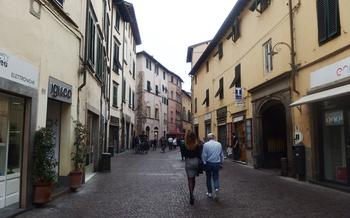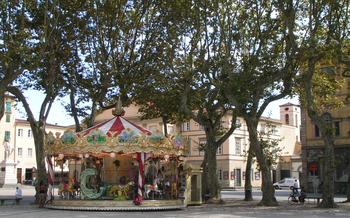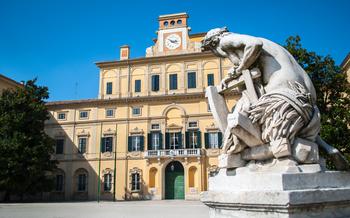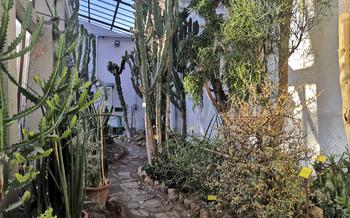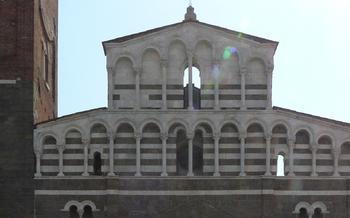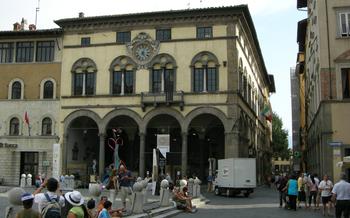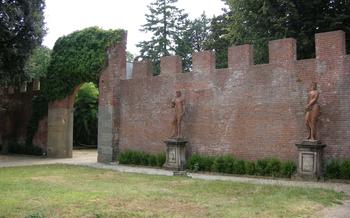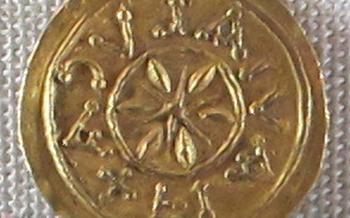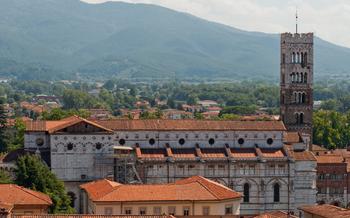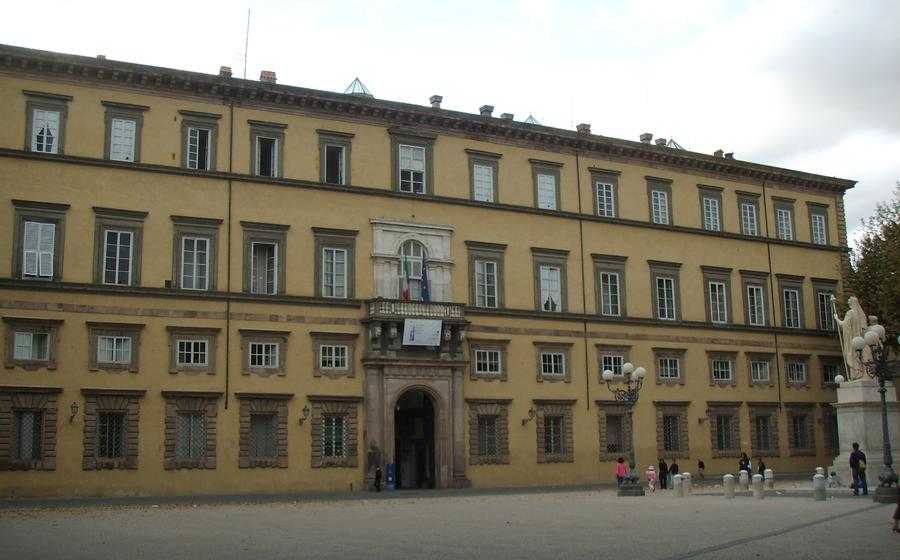
Palazzo Ducale
- History and Origin
- Architecture and Design
- Art and Collections
- Museo Nazionale di Villa Guinigi
- Public Events and Exhibitions
- Guided Tours and Accessibility
- The Torre delle Ore
- The Loggia degli Svizzeri
- The Chapel of Saint Paolino
- The Hall of Mirrors: A Reflection of Grandeur
- The State Apartments
- Temporary Exhibitions
- Insider Tip:
History and Origin
The Palazzo Ducale, a magnificent testament to Lucca's rich history, stands as a symbol of the city's political and cultural heritage. Its origins can be traced back to the 14th century, when the Republic of Lucca decided to construct a grand palace to serve as the seat of its government. The palace's design was entrusted to Bartolomeo Ammannati and Francesco di Giorgio Martini, two renowned architects of the Renaissance period.
The Palazzo Ducale's architecture reflects a blend of Gothic and Renaissance styles, a testament to the evolving artistic influences that shaped Lucca's cityscape. The facade, adorned with intricate carvings and elegant loggias, exudes a sense of grandeur and opulence. The palace's imposing towers, a defining feature of its skyline, served as watchtowers and defensive structures during times of conflict, demonstrating the building's dual purpose as a seat of power and a fortress.
Over the centuries, the Palazzo Ducale has witnessed the rise and fall of powerful families and rulers who left their mark on its history. The Guinigi family, one of Lucca's most prominent dynasties, resided in the palace during the 15th century, adding to its legacy of opulence and grandeur. The palace also served as the residence of Elisa Baciocchi, Napoleon Bonaparte's sister, during her reign as Princess of Lucca and Piombino.
Architecture and Design
The Palazzo Ducale boasts a captivating architectural design that blends various styles, reflecting the diverse periods of its construction and occupation. Its imposing facade, adorned with intricate carvings and sculptures, showcases the Renaissance influence. The elegant arches and columns of the courtyard evoke a classical Roman style. The sturdy towers, reminiscent of medieval fortifications, add a touch of defensiveness to the structure.
The use of local materials, such as limestone and marble, not only adds to the building's durability but also creates a harmonious connection with the surrounding environment. The combination of these architectural elements results in a unique and cohesive masterpiece that narrates Lucca's rich history through its design.
The interior of the Palazzo Ducale is equally impressive, featuring a series of grand halls, chambers, and corridors. Each room is adorned with intricate frescoes, tapestries, and paintings, showcasing the artistic talents of renowned masters. The Hall of Mirrors, in particular, stands out for its opulent decor, featuring an array of mirrors that create an illusion of infinite space. The State Apartments, with their lavish furnishings and precious artwork, offer a glimpse into the luxurious lifestyle of the palace's former occupants.
The Palazzo Ducale's architecture and design not only serve as a testament to the skill and artistry of its creators but also provide a tangible connection to Lucca's past, offering visitors a glimpse into the city's rich history and cultural heritage.
Art and Collections
The Palazzo Ducale boasts a magnificent collection of art that encompasses paintings, sculptures, tapestries, and furnishings, which collectively offer a glimpse into the discerning taste and opulence of Lucca's former rulers. Among the notable artists whose works grace the palace walls are Jacopo della Quercia, Pisaniello, and Filippino Lippi. Each piece in the collection tells a story, showcasing the evolution of artistic styles and techniques from the Middle Ages to the Renaissance.
One of the most captivating paintings is "Madonna and Child with Angels" by Filippino Lippi, which exudes a sense of serenity and grace with its soft brushstrokes and vibrant colors. Another highlight is the intricately carved wooden statue of "Saint Michael" by Jacopo della Quercia, which showcases the artist's mastery of anatomical detail and emotional expression. The renowned "Madonna del Latte" by Pisaniello is a testament to the artist's skill in portraying the tender bond between mother and child.
These are just a few examples of the artistic treasures housed within the Palazzo Ducale. Each piece has its own unique history and significance, waiting to be discovered and appreciated by visitors from around the world.
Museo Nazionale di Villa Guinigi
The Palazzo Ducale is closely associated with the Museo Nazionale di Villa Guinigi, which is housed in a magnificent villa located nearby. This museum boasts an impressive collection of art and artifacts that complement the exhibits found within the palace. The connection between the two institutions allows visitors to immerse themselves in a comprehensive exploration of Lucca's rich cultural heritage.
The Museo Nazionale di Villa Guinigi showcases a diverse range of exhibits, including paintings, sculptures, and decorative arts from various eras. Notable highlights include works by renowned artists such as Filippino Lippi, Tintoretto, and Paolo Uccello. The museum also features a remarkable collection of medieval and Renaissance manuscripts, providing a glimpse into the city's intellectual and artistic achievements during those periods.
Visitors to the Museo Nazionale di Villa Guinigi can discover intriguing stories behind the artifacts on display. One such tale revolves around the acquisition of a precious silver statue of the Madonna and Child. Legend has it that the statue was found buried beneath the villa's garden, adding an air of mystery and fascination to the museum's collection.
My personal experience exploring the Museo Nazionale di Villa Guinigi was truly enriching. The combination of stunning artworks and captivating historical narratives transported me back in time, allowing me to connect with Lucca's vibrant past. I highly recommend visitors to explore both the Palazzo Ducale and the Museo Nazionale di Villa Guinigi to gain a comprehensive understanding of this remarkable city's cultural treasures.
Public Events and Exhibitions
The Palazzo Ducale is not just a historical monument but also a vibrant cultural hub that hosts a variety of public events and exhibitions throughout the year. These events showcase Lucca's rich cultural heritage and provide opportunities for visitors to engage with the palace in new and exciting ways.
From art exhibitions featuring local and international artists to historical reenactments and traditional festivals, the Palazzo Ducale offers a diverse range of events that cater to different interests and tastes. These events not only bring the palace's history to life but also create a sense of community and foster cultural exchange.
One of the most popular events held at the Palazzo Ducale is the annual "Lucca Comics & Games" festival, which attracts thousands of visitors from around the world. This festival celebrates all things pop culture, including comics, games, anime, and cosplay. The palace's grand halls and courtyards are transformed into a vibrant marketplace, where vendors sell unique merchandise, artists showcase their work, and fans gather to meet their favorite creators.
Another highlight is the "Lucca Film Festival," which screens a selection of independent and international films in the atmospheric setting of the palace's courtyard. The festival attracts filmmakers, actors, and film enthusiasts from around the globe, creating a buzz of excitement and creativity.
These events not only contribute to Lucca's vibrant cultural scene but also provide visitors with a unique opportunity to experience the Palazzo Ducale in a different light. Whether you're an art lover, a history buff, or simply looking for a fun and engaging way to spend an evening, the Palazzo Ducale's public events offer something for everyone.
Guided Tours and Accessibility
- Guided Tours:
- Guided tours of the Palazzo Ducale are available in various languages, offering an immersive and informative experience.
- The tours provide insights into the palace's history, architecture, art collection, and its significance in Lucca's cultural heritage.
-
Visitors can learn about the different sections of the palace, including the State Apartments, the Hall of Mirrors, and the Museo Nazionale di Villa Guinigi.
-
Highlights and Insights:
- During the tours, visitors can admire the intricate details of the palace's architecture, such as the coffered ceilings and the monumental staircase.
- Guides share fascinating stories about the families and rulers who occupied the palace, as well as the events that unfolded within its walls.
-
Visitors gain a deeper understanding of the art collection, including the works of famous artists like Tintoretto, Veronese, and Pontormo.
-
Accessibility Features:
- The Palazzo Ducale is committed to providing an accessible and inclusive environment for all visitors.
- The palace is equipped with ramps, elevators, and wheelchair-accessible restrooms, ensuring that visitors with disabilities can fully enjoy their visit.
-
Visitors with disabilities can request assistance from the staff to ensure a smooth and enjoyable experience.
-
Booking Tours:
- Booking a guided tour in advance is recommended, especially during peak tourist season, to secure a spot and avoid long lines.
- Visitors can book tours online, through the palace's official website, or by contacting the tourist information office in Lucca.
- Group bookings and customized tours can also be arranged upon request.
The Torre delle Ore
Amidst the architectural grandeur of the Palazzo Ducale, the Torre delle Ore stands tall as a symbol of Lucca's rich history. This majestic clock tower, with its intricate mechanisms and striking appearance, has played a pivotal role in the civic life of the city for centuries. Its melodious chimes have echoed through the streets of Lucca, marking the passage of time and shaping the rhythm of daily life.
The origins of the Torre delle Ore can be traced back to the 14th century when the Palazzo Ducale was undergoing extensive renovations. The tower was conceived as a practical addition to the palace, serving as a timekeeping device for the city's inhabitants. Its construction was entrusted to skilled craftsmen and engineers who meticulously designed and assembled the intricate mechanisms that would drive the clock.
Over the centuries, the Torre delle Ore has undergone several modifications and embellishments, reflecting the changing tastes and styles of different eras. In the 15th century, the tower was adorned with a beautiful clock face featuring Roman numerals and intricate carvings. The clock's hands, crafted from wrought iron, were designed to withstand the elements and provide accurate timekeeping even in challenging weather conditions.
In the 17th century, the tower underwent a significant restoration, during which the original wooden structure was reinforced with stone and brick. The tower's height was also increased, making it even more prominent in the city's skyline. The renovations also included the addition of a bell chamber, housing a large bell that would toll the hours and mark special occasions.
The Torre delle Ore has witnessed countless historical events unfold from its lofty perch. It has stood as a silent observer of wars, celebrations, and the changing fortunes of Lucca. Its chimes have rung out to signal victories, mourn losses, and mark the passage of generations.
Today, the Torre delle Ore continues to captivate visitors with its timeless beauty and historical significance. Its intricate mechanisms, which have been meticulously preserved and maintained, continue to tell the time with remarkable accuracy. The tower remains a beloved landmark, a symbol of Lucca's rich heritage, and a testament to the ingenuity and craftsmanship of its builders.
The Loggia degli Svizzeri
Amidst the grandeur of the Palazzo Ducale, one finds the elegant Loggia degli Svizzeri, a historical and architectural gem. Built in the 16th century, this loggia served as a gathering place for Swiss mercenaries who were part of Lucca's military forces. Its construction reflects the city's reliance on these skilled soldiers and the strong ties between Lucca and the Swiss cantons.
The loggia is characterized by its graceful arches, slender columns, and intricate decorative elements. The ceiling is adorned with beautiful frescoes depicting scenes from Swiss history and mythology, adding a touch of artistic charm to the space. Visitors can admire the delicate details and vibrant colors of these frescoes, which narrate tales of bravery, loyalty, and the deep connection between Lucca and its Swiss allies.
Step into the Loggia degli Svizzeri and immerse yourself in the history of Lucca's military prowess and its enduring relationship with the Swiss. This architectural gem offers a unique glimpse into the city's past, showcasing the significance of its collaborations and the legacy of its diverse cultural influences.
The Chapel of Saint Paolino
Nestled within the walls of the Palazzo Ducale, the Chapel of Saint Paolino stands as a testament to the religious devotion and artistic prowess of Lucca's past. Dedicated to the patron saint of the city, Saint Paolino, the chapel exudes an atmosphere of tranquility and reverence that invites visitors to pause and reflect.
Built in the 14th century, the chapel underwent significant renovations in the 16th century, resulting in a harmonious blend of Gothic and Renaissance architectural styles. Its interior is a treasure trove of artistic masterpieces, adorned with intricate frescoes, sculptures, and stained-glass windows that depict scenes from the life of Saint Paolino and other biblical figures.
Of particular note is the altarpiece by the renowned Renaissance artist Filippino Lippi, a stunning work that portrays the Madonna and Child surrounded by a celestial chorus of angels. The chapel's walls are adorned with frescoes depicting the life of Saint Paolino, created by the talented artists Amico Aspertini and Bernardino Luini. These vibrant and expressive murals bring to life the saint's miraculous deeds and his enduring legacy as the protector of Lucca.
A visit to the Chapel of Saint Paolino offers a profound spiritual experience, allowing visitors to connect with the city's rich religious heritage and appreciate the artistic treasures that grace its sacred spaces. Whether you are a pilgrim seeking solace or an art enthusiast marveling at the works of master painters, this hidden gem within the Palazzo Ducale will leave an indelible mark on your soul.
The Hall of Mirrors: A Reflection of Grandeur
Step into the Hall of Mirrors, a dazzling showcase of opulence and artistry within the Palazzo Ducale. This grand hall, once used for lavish receptions and banquets, emanates an aura of grandeur that transports visitors back in time. The walls are adorned with an intricate arrangement of mirrors, reflecting the shimmering light of crystal chandeliers and creating an illusion of endless space. The ceiling is a masterpiece of frescoes depicting mythological scenes and allegorical figures, adding to the hall's celestial ambiance.
Beneath your feet, the intricate parquet flooring inlays create a mesmerizing pattern that complements the overall splendor of the room. Every corner of the Hall of Mirrors exudes elegance, from the ornate fireplaces to the gilded furniture that once hosted royalty and dignitaries. Stand in the center of the hall and let your gaze wander, taking in the exquisite details that make this space truly unforgettable.
Imagine the scene centuries ago, as noblemen and women danced beneath the shimmering chandeliers, their reflections dancing alongside them in the mirrors. The hall echoed with laughter, music, and the clinking of glasses, creating a symphony of celebration. Even today, the Hall of Mirrors retains its majestic charm, serving as a reminder of the Palazzo Ducale's illustrious past.
The State Apartments
The State Apartments, located within the Palazzo Ducale, offer a glimpse into the opulent lifestyle of the palace's former occupants. These grand rooms, once reserved for the ruling families, are now open to the public, allowing visitors to experience the grandeur and history that permeates every corner.
The State Apartments comprise a series of interconnected rooms, each with its own unique character and purpose. The Sala del Trono, or Throne Room, is particularly impressive, with its towering ceiling, intricate frescoes, and opulent furnishings. The Sala della Musica, or Music Room, features a collection of antique musical instruments, while the Sala da Pranzo, or Dining Room, showcases a long table that could accommodate up to 40 guests.
Visitors can wander through these stately rooms, admiring the fine art, tapestries, and furniture that adorn the walls. The State Apartments provide a fascinating glimpse into the lives of the powerful families who once ruled Lucca, and offer a tangible connection to the city's rich history.
Temporary Exhibitions
The Palazzo Ducale is not only a historical monument but also a vibrant cultural hub that hosts a variety of temporary exhibitions throughout the year. These exhibitions showcase a diverse range of art, history, and contemporary installations, providing visitors with a platform to engage with new ideas and perspectives. The palace's commitment to hosting such events reflects its ongoing role as a center for cultural exchange and dialogue.
From captivating art retrospectives to thought-provoking historical displays and cutting-edge contemporary installations, the temporary exhibitions at the Palazzo Ducale offer something for every visitor. Whether you're an art enthusiast, a history buff, or simply looking for a unique cultural experience, you're sure to find something of interest here.
These exhibitions not only enhance the palace's appeal to visitors but also contribute to the cultural fabric of Lucca. They provide a platform for local and international artists to showcase their work, foster dialogue on important social and cultural issues, and promote cross-cultural understanding.
Insider Tip: Keep an eye out for special events and workshops that often accompany these temporary exhibitions. These events offer a chance to engage with the artists, learn more about their work, and participate in hands-on activities.
Insider Tip:
Delve into the Palazzo Ducale's fascinating past by visiting the restored prison cells beneath the palace. These hidden chambers, once holding convicted criminals, have been transformed into an eerie yet captivating museum. Explore the dimly lit corridors, peruse the exhibits detailing the lives of former inmates, and gain a deeper understanding of the palace's darker history. This unique experience offers a glimpse into a less glamorous side of the Palazzo Ducale, providing a haunting contrast to its opulent grandeur.
